Notes: Norham is a small, attractive village famous for its ruined castle and surrounded by rich agricultural land. The NER Tweedmouth – Kelso Branch was conceived more as a through route than one to serve the local population conveniently, as seen by the failure of the line to pass through the principal settlements of Coldstream and Kelso, and it also missed Norham by half a mile. This station remained isolated throughout its life, never attracting any housing or industry, although it possessed quite a large and busy goods yard.
 The stationmaster’s house was on the down (Kelso-bound) side of the railway which was on an embankment. The upper-storey windows looked out onto the platform whilst the ground floor was level with the station approach road. The shape of the building as seen from the road was similar to its neighbour at Velvet Hall but it lacked the latter’s dormers and thus looked plainer. The appearance of the building from the platform was somewhat unbalanced thanks to the generous height of the roof above the single visible storey. A stone-built extension with a small gable was at the north-east end of the station building adjacent to the platform ramp. A hipped-roofed signal box was added to the down platform south-west of the station building circa 1880 when the block system was introduced. On the up platform an enclosed timber waiting shed, understood to have contained a ladies’ waiting room and toilet, was provided by the NER, its extremely tall pent roof sloping down towards the rear of the platform. A pedestrian pathway led from the road to the up platform. A barrow crossing was installed adjacent to the ramps at both ends of the platforms; the station never possessed a footbridge or subway. The down platform was 101yd in length and the up a little longer at 107yd. However, in the early 1950s the up platform was considerably shortened at its western end. The stationmaster’s house was on the down (Kelso-bound) side of the railway which was on an embankment. The upper-storey windows looked out onto the platform whilst the ground floor was level with the station approach road. The shape of the building as seen from the road was similar to its neighbour at Velvet Hall but it lacked the latter’s dormers and thus looked plainer. The appearance of the building from the platform was somewhat unbalanced thanks to the generous height of the roof above the single visible storey. A stone-built extension with a small gable was at the north-east end of the station building adjacent to the platform ramp. A hipped-roofed signal box was added to the down platform south-west of the station building circa 1880 when the block system was introduced. On the up platform an enclosed timber waiting shed, understood to have contained a ladies’ waiting room and toilet, was provided by the NER, its extremely tall pent roof sloping down towards the rear of the platform. A pedestrian pathway led from the road to the up platform. A barrow crossing was installed adjacent to the ramps at both ends of the platforms; the station never possessed a footbridge or subway. The down platform was 101yd in length and the up a little longer at 107yd. However, in the early 1950s the up platform was considerably shortened at its western end.
The 1851 National Census records that John Taylor was stationmaster. By the time of the next census (1861) William B Glaholm was in this post and he retained it into the next century. The 1871 and 1881 censuses indicate that in addition to himself and his wife, seven members of his family were accommodated in the station house.
Bradshaw of March 1850 gives the train service between ‘Sprouston (Kelso)’ and Tweedmouth in a narrative form with only the times of departure from the two termini stated and no reference to Norham or any other intermediate stations. Departures from Sprouston on weekdays are at 1.15am (stated as 1¼ morn.) – surely a mistake? – and at 2.45 and 6.20pm. On Sunday there are departures at 9.00am and 7.00pm. The February 1863 timetable gives specific departure times from Norham, as seen below.
February 1863
Up trains: weekdays |
Destination |
Down trains: weekdays |
Destination |
7.51am |
Berwick |
9.04am |
Kelso |
10.51am |
Berwick |
2.04pm |
Kelso |
3.46pm |
Berwick |
4.48pm |
Kelso |
7.46pm |
Berwick |
7.22pm |
Kelso |
Up trains: Sunday |
|
Down trains: Sunday |
|
9.26am |
Berwick |
7.19am |
Kelso |
8.00pm |
Berwick |
4.49pm |
Kelso |
By August 1887 the weekday train frequency had increased. This timetable pre-dates the opening of the Coldstream – Alnwick line by two months.
August 1887 Up trains: weekdays |
Destination |
Down trains: weekdays |
Destination |
8.42am |
Berwick |
8.57am |
Kelso |
10.37am |
Berwick |
11.52am |
Kelso |
1.17pm |
Berwick |
2.32pm |
Kelso |
3.57pm |
Berwick |
5.02pm |
Kelso |
8.17pm |
Berwick |
7.08pm |
Kelso |
- |
- |
8.08pm |
Kelso |
Up trains: Sunday |
Destination |
Down trains: Sunday |
Destination |
9.52am |
Berwick |
7.52am |
Kelso |
8.22pm |
Berwick |
5.52pm |
Kelso |
In January 1902 the original N1-type, stone-based signal box was closed and replaced with one of pitched-roof design (N4, Northern Division standard top on an N2 brick base with McKenzie & Holland 20-lever frame) a short distance beyond the up platform ramp. The closed box was demolished and a timber stationmaster’s office/general room and booking office was added to the western end of stationmaster’s house. Continuing westwards there was a narrow staircase / luggage slide followed by a further stone building, a porters’ rest area and office, containing two rooms, one with a fireplace and both with casement windows overlooking the goods yard. At ground level, a single-storey stone pent-roofed building adjoined the porters’ room on the south side; this was the weighbridge (and probably general administration) office with the weighbridge directly in front of it. The final building, at the western end of the ensemble, was the ‘passenger warehouse’ where small packages and luggage was stored. Dean (2003/2011) comments that as a result of the various additions, ‘the overall impression of the station, when seen from the platform level, was somewhat spoiled by a hotchpotch of stone and wooden buildings – a reflection of development over a period’.
At the entrance to the forecourt, standing perpendicular to the stationmaster’s house, was a stone-built single-storey structure with a hipped roof which is understood to have been a wash house and men’s toilet. Evidence of the washhouse facility can be confirmed by the cooking/fire place and wash copper still in place in one room, whilst the other windowless room has no discernible features aside from a small cast iron vent flue on an outside wall.
 The Railway Clearing House Handbook of 1904 indicates that Norham station handled a full range of goods traffic and a 15cwt crane was provided in the extensive goods yard. The surrounding area was agriculturally productive with both arable and pastoral farming; in 1913 the principal crop handled was barley (1,407 tons) and 485 wagons of livestock were loaded at the station. Rabbits were also caught in the neighbourhood and were regularly dispatched from Norham. As at many other stations coal was brought in and distributed within the local area. A station plan dated 1909 shows five sidings on the down side; closest to the down platform one siding served the coal depot; to its south two sidings served the lime depot; a further siding to the goods warehouse abutted the loading dock and a final short siding (43yd) stopped short at the dock. Both the lime depot and goods shed were of stone construction with slate roofs, the former of hipped profile and the latter pitched. The Railway Clearing House Handbook of 1904 indicates that Norham station handled a full range of goods traffic and a 15cwt crane was provided in the extensive goods yard. The surrounding area was agriculturally productive with both arable and pastoral farming; in 1913 the principal crop handled was barley (1,407 tons) and 485 wagons of livestock were loaded at the station. Rabbits were also caught in the neighbourhood and were regularly dispatched from Norham. As at many other stations coal was brought in and distributed within the local area. A station plan dated 1909 shows five sidings on the down side; closest to the down platform one siding served the coal depot; to its south two sidings served the lime depot; a further siding to the goods warehouse abutted the loading dock and a final short siding (43yd) stopped short at the dock. Both the lime depot and goods shed were of stone construction with slate roofs, the former of hipped profile and the latter pitched.
The station’s catchment area was reckoned in 1911 to contain 2,200 people and in that year 14,277 tickets were sold.

William B Glaholm who had been stationmaster since at least 1861 died in April 1905. It is not clear who occupied this role until February 1911 when William Milner was appointed; he was in post until July 1918, and from September 1918 until March 1943 the stationmaster was Mr H T Short. It was during his period of office that ownership of the line and station was transferred in January 1923 from the NER to the new London & North Eastern Railway (LNER).
The timetable for July 1920, towards the end of the NER era, shows that Sunday services are still provided on the Kelso Branch, and that two of the Berwick - Coldstream – Alnwick trains call at Norham – one such train calls in the opposite direction.
July 1920 Up trains: weekdays |
Destination |
Down trains: weekdays |
Destination |
8.23am |
Berwick |
6.32am |
Alnwick |
10.40am |
Berwick |
9.01am |
Kelso |
4.02pm |
Berwick |
2.41pm |
Kelso |
8.37pm |
Berwick |
4.14pm |
Alnwick |
- |
- |
6.21pm |
Kelso |
Up trains: Sunday |
Destination |
Down trains: Sunday |
Destination |
10.10am |
Berwick |
8.47am |
Kelso |
7.50pm |
Berwick |
6.22pm |
Kelso |
During the 1920s and ‘30s competition from road motor transport began to assert itself. By summer 1931 Young’s Motor Service provided buses between Norham, Horncliffe, Ord and Berwick with five Monday-to-Friday trips between Norham and Berwick, six on Saturday and four on Sunday. On weekdays four further runs were provided between Horncliffe and Berwick. The same frequency operated in the opposite direction apart from there being only three Berwick – Horncliffe trips. The buses served Norham village directly, unlike the trains which called at its station an inconvenient distance from the village. As an economy measure the LNER used a Sentinel steam car to operate some services (indicated here by * ‘One class only’ in the timetable).
September 1937 Up trains: weekdays |
Destination |
Down trains: weekdays |
Destination |
8.25am * |
Berwick |
7.51am * |
Coldstream |
10.35am |
Berwick |
9.05am |
Kelso |
1.05pm * |
Berwick |
11.50am * |
Kelso |
3.39pm |
Berwick |
2.18pm |
Kelso |
7.11pm |
Berwick |
5.46pm |
St Boswells |
- |
- |
9.43pm SO * |
Sunilaws |
Sunday: no trains |
|
Sunday: no trains |
|
SO Saturday only * One class only
During the LNER era Norham station was not significantly altered, and it retained oil lighting. Mr Short, the Norham stationmaster was given responsibility for neighbouring Velvet Hall (probably in 1931). After his long period of office ended he was succeeded by Mr N Liddle who held the Norham and Velvet Hall post from June 1943 until March 1946.
 In January 1948 nationalisation of the railways placed Norham within the North Eastern Region (NE) of British Railways (BR). Under the new administration the station retained its antiquated appearance and a service of four trains each way on weekdays only. The stationmaster was Mr W A Watson who had been appointed in August 1947 with supervision of Twizell station added to his responsibility for Norham and Velvet Hall. He was in post until November 1954; during his period of office Twizell station ceased to be staffed. At some stage between July 1952 and September 1955 the western end of the up platform at Norham was demolished and it was replaced with a path to provide access to the signal box. In January 1948 nationalisation of the railways placed Norham within the North Eastern Region (NE) of British Railways (BR). Under the new administration the station retained its antiquated appearance and a service of four trains each way on weekdays only. The stationmaster was Mr W A Watson who had been appointed in August 1947 with supervision of Twizell station added to his responsibility for Norham and Velvet Hall. He was in post until November 1954; during his period of office Twizell station ceased to be staffed. At some stage between July 1952 and September 1955 the western end of the up platform at Norham was demolished and it was replaced with a path to provide access to the signal box.
A review of the Berwick – Kelso – St Boswells line’s viability in 1953/54 concluded that five of the stations on the former NER section should close. Although Norham station booked very few passengers (701 in 1951) this figure exceeded its neighbours Twizell (537) and Velvet Hall (176) and Norham remained open.
February 1955 Up trains: weekdays |
Destination |
Down trains: weekdays |
Destination |
8.09am |
Berwick-upon-Tweed |
6.52am |
St Boswells |
10.06am |
Berwick-upon-Tweed |
9.40am |
St Boswells |
5.17pm |
Berwick-upon-Tweed |
3.48pm |
St Boswells |
8.35pm |
Berwick-upon-Tweed |
7.07pm |
St Boswells |
Sunday: no trains |
|
Sunday: no trains |
|
SO Saturday only SX Saturday excepted
The June 1955 service differs only in that 10.06am and 3.48pm departures are retimed on Saturday only.
Coinciding with the closure of the neighbouring stations in July 1955 the train service was halved to only two trains in each direction on weekdays. In 1962 the train service, shown below, remained threadbare. Since September 1961 Norham station had been unstaffed when the evening down train departed. The station showed no evidence of modernisation, with oil lighting and wooden nameboards; in contrast the Scottish Region stations on the line had all been fitted with BR totem signs and enamel running-in boards. It is possible that the up platform shelter was demolished about this time.
September 1962 Up trains: weekdays |
Destination |
Down trains: weekdays |
Destination |
9.19am |
Berwick-upon-Tweed |
10.17am |
St Boswells |
5.23pm |
Berwick-upon-Tweed |
6.56pm |
St Boswells |
Sunday: no trains |
|
Sunday: no trains |
|
Prior to the publication of the ‘Beeching Report’ of March 1963 the decision had been made to close the Berwick – Kelso – St Boswells line to passenger traffic, but the service struggled on until its withdrawal on 15 June 1964. Whereas most of the services in BR(NE) were diesel-operated by this time, all of Norham’s trains were steam-hauled. Goods traffic was handled at Norham until 29 March 1965 when the line from Tweedmouth to Kelso closed to all traffic.
The station’s final stationmaster, Peter Short, and his family purchased the station and its grounds in 1970 for the sum of £800. Mr Short continued to operate from the station as a coal merchant; many stationmasters in north-east England provided this service. He proceeded to restore the station sensitively, inside and out, as a private museum with signs, lanterns and other ‘railwayana’ which portrayed its historic character. Although no rails were reinstated the trackbed and sidings were given over to an immaculately presented lawn, and the whole site was made extremely attractive. On 18 April 1971 the railway bridge over Norham Station Road was dismantled.
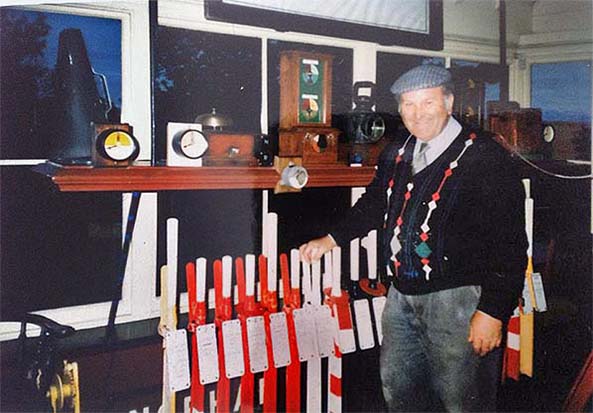 Peter Short, the last stationmaster at Norham, at the station signal box frame. He continued to live at the station after its closure in 1965 and five years later purchased the site and set about transforming it into a museum. The photograph is undated. Peter Short, the last stationmaster at Norham, at the station signal box frame. He continued to live at the station after its closure in 1965 and five years later purchased the site and set about transforming it into a museum. The photograph is undated.
Photo from Railways of Berwick and the Eastern Borders Facebook Group
In 1988 the station and its main buildings were granted Grade II listed status. Following the death of Mr Short and his wife the ‘museum’ exhibits were removed and the station and its grounds were purchased by Neil and Annette Harris who moved into the house in December 2016 and, in their own words, intend ‘to continue and enhance the preservation of Norham station’. Their website www.norhamstation.co.uk is highly recommended and the author is grateful for their support and encouragement in compiling this article and for recent photographs taken specifically to accompany it.
Tickets from Michael Stewart. Station certiuficates from Railways of Berwick & the Eastern Borders Facebook Group. Route map drawn by Alan Young
Click here to see estate agent's sale brochure.
Click here for a brief history of the
Tweedmouth - St Boswells line
To see other stations on the Tweedmouth - St Boswells line click on the station name: Tweedmouth, Velvet Hall, Twizell, Coldstream, Sunilaws, Carham, Sprouston, Kelso, Wallace Nick, Roxburgh, Rutherford & Maxton & St Boswells
See also Jedburgh branch: Kirkbank, Nisbet, Jedfoot & Jedburgh |



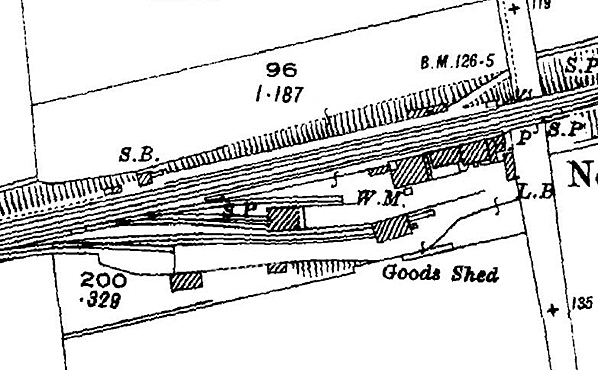 1924 1:2,500 OS map. Norham station is in sparsely populated countryside about ½-mile south of the village that it serves. The station building is at the eastern end of the up (south) platform. Whereas the 1898 edition of this map showed the signal box a short distance west, also on the platform, this 1924 map shows the new box at the western end of the up platform. New buildings have been constructed on and close to the site of the old box. The goods facilities include the goods shed (named) and the unnamed lime depot entered by a pair of sidings; a goods loading bank extends west of the named shed serving the southernmost siding. The northernmost siding leads to the coal depot, which is not named but the weigh office (‘W.M.’ – weighing machine) is shown.
1924 1:2,500 OS map. Norham station is in sparsely populated countryside about ½-mile south of the village that it serves. The station building is at the eastern end of the up (south) platform. Whereas the 1898 edition of this map showed the signal box a short distance west, also on the platform, this 1924 map shows the new box at the western end of the up platform. New buildings have been constructed on and close to the site of the old box. The goods facilities include the goods shed (named) and the unnamed lime depot entered by a pair of sidings; a goods loading bank extends west of the named shed serving the southernmost siding. The northernmost siding leads to the coal depot, which is not named but the weigh office (‘W.M.’ – weighing machine) is shown.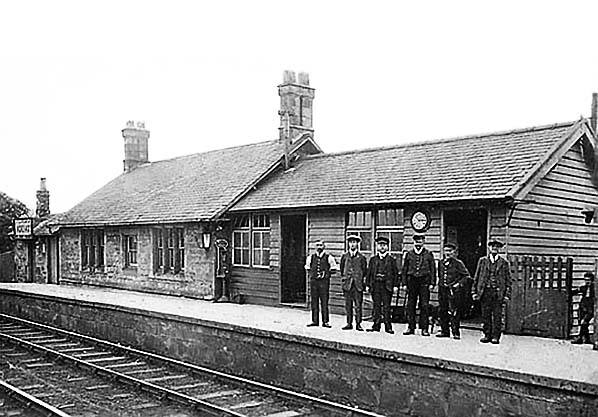
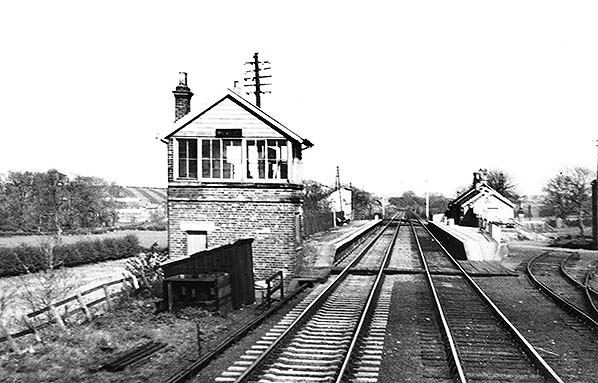

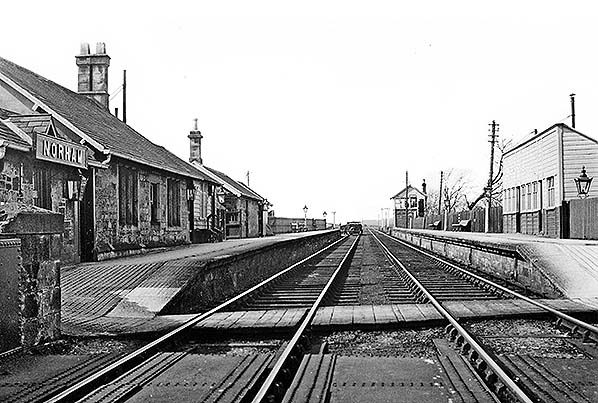


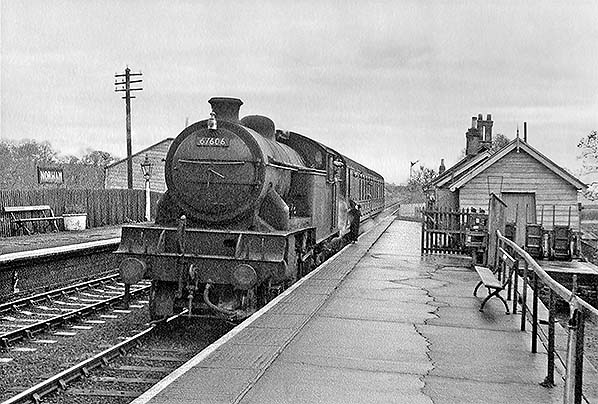
 The stationmaster’s house was on the down (Kelso-bound) side of the railway which was on an embankment. The upper-storey windows looked out onto the platform whilst the ground floor was level with the station approach road. The shape of the building as seen from the road was similar to its neighbour at Velvet Hall but it lacked the latter’s dormers and thus looked plainer. The appearance of the building from the platform was somewhat unbalanced thanks to the generous height of the roof above the single visible storey. A stone-built extension with a small gable was at the north-east end of the station building adjacent to the platform ramp. A hipped-roofed signal box was added to the down platform south-west of the station building circa 1880 when the block system was introduced. On the up platform an enclosed timber waiting shed, understood to have contained a ladies’ waiting room and toilet, was provided by the NER, its extremely tall pent roof sloping down towards the rear of the platform. A pedestrian pathway led from the road to the up platform. A barrow crossing was installed adjacent to the ramps at both ends of the platforms; the station never possessed a footbridge or subway. The down platform was 101yd in length and the up a little longer at 107yd. However, in the early 1950s the up platform was considerably shortened at its western end.
The stationmaster’s house was on the down (Kelso-bound) side of the railway which was on an embankment. The upper-storey windows looked out onto the platform whilst the ground floor was level with the station approach road. The shape of the building as seen from the road was similar to its neighbour at Velvet Hall but it lacked the latter’s dormers and thus looked plainer. The appearance of the building from the platform was somewhat unbalanced thanks to the generous height of the roof above the single visible storey. A stone-built extension with a small gable was at the north-east end of the station building adjacent to the platform ramp. A hipped-roofed signal box was added to the down platform south-west of the station building circa 1880 when the block system was introduced. On the up platform an enclosed timber waiting shed, understood to have contained a ladies’ waiting room and toilet, was provided by the NER, its extremely tall pent roof sloping down towards the rear of the platform. A pedestrian pathway led from the road to the up platform. A barrow crossing was installed adjacent to the ramps at both ends of the platforms; the station never possessed a footbridge or subway. The down platform was 101yd in length and the up a little longer at 107yd. However, in the early 1950s the up platform was considerably shortened at its western end. The Railway Clearing House Handbook of 1904 indicates that Norham station handled a full range of goods traffic and a 15cwt crane was provided in the extensive goods yard. The surrounding area was agriculturally productive with both arable and pastoral farming; in 1913 the principal crop handled was barley (1,407 tons) and 485 wagons of livestock were loaded at the station. Rabbits were also caught in the neighbourhood and were regularly dispatched from Norham. As at many other stations coal was brought in and distributed within the local area. A station plan dated 1909 shows five sidings on the down side; closest to the down platform one siding served the coal depot; to its south two sidings served the lime depot; a further siding to the goods warehouse abutted the loading dock and a final short siding (43yd) stopped short at the dock. Both the lime depot and goods shed were of stone construction with slate roofs, the former of hipped profile and the latter pitched.
The Railway Clearing House Handbook of 1904 indicates that Norham station handled a full range of goods traffic and a 15cwt crane was provided in the extensive goods yard. The surrounding area was agriculturally productive with both arable and pastoral farming; in 1913 the principal crop handled was barley (1,407 tons) and 485 wagons of livestock were loaded at the station. Rabbits were also caught in the neighbourhood and were regularly dispatched from Norham. As at many other stations coal was brought in and distributed within the local area. A station plan dated 1909 shows five sidings on the down side; closest to the down platform one siding served the coal depot; to its south two sidings served the lime depot; a further siding to the goods warehouse abutted the loading dock and a final short siding (43yd) stopped short at the dock. Both the lime depot and goods shed were of stone construction with slate roofs, the former of hipped profile and the latter pitched. 
 In January 1948 nationalisation of the railways placed Norham within the North Eastern Region (NE) of British Railways (BR). Under the new administration the station retained its antiquated appearance and a service of four trains each way on weekdays only. The stationmaster was Mr W A Watson who had been appointed in August 1947 with supervision of Twizell station added to his responsibility for Norham and Velvet Hall. He was in post until November 1954; during his period of office Twizell station ceased to be staffed. At some stage between July 1952 and September 1955 the western end of the up platform at Norham was demolished and it was replaced with a path to provide access to the signal box.
In January 1948 nationalisation of the railways placed Norham within the North Eastern Region (NE) of British Railways (BR). Under the new administration the station retained its antiquated appearance and a service of four trains each way on weekdays only. The stationmaster was Mr W A Watson who had been appointed in August 1947 with supervision of Twizell station added to his responsibility for Norham and Velvet Hall. He was in post until November 1954; during his period of office Twizell station ceased to be staffed. At some stage between July 1952 and September 1955 the western end of the up platform at Norham was demolished and it was replaced with a path to provide access to the signal box. Peter Short, the last stationmaster at Norham, at the station signal box frame. He continued to live at the station after its closure in 1965 and five years later purchased the site and set about transforming it into a museum. The photograph is undated.
Peter Short, the last stationmaster at Norham, at the station signal box frame. He continued to live at the station after its closure in 1965 and five years later purchased the site and set about transforming it into a museum. The photograph is undated.
 Home Page
Home Page